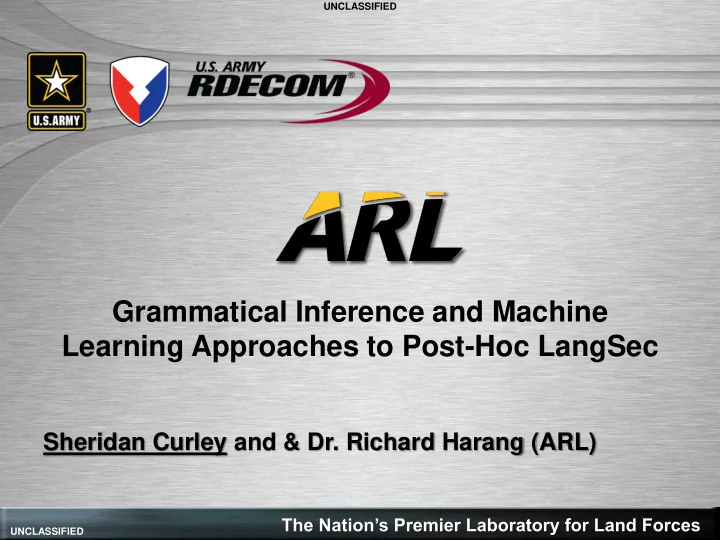

UNCLASSIFIED UNCLASSIFIED Grammatical Inference and Machine Learning Approaches to Post-Hoc LangSec Sheridan Curley and & Dr. Richard Harang (ARL) The Nation’s Premier Laboratory for Land Forces The Nation’s Premier Laboratory for Land Forces UNCLASSIFIED UNCLASSIFIED
UNCLASSIFIED Outline Theory approach – Grammatical inference – LangSec Paper’s work – Machine learning to bypass hardness – Our experimental setup – Results Moving Forward Conclusion The Nation’s Premier Laboratory for Land Forces UNCLASSIFIED
UNCLASSIFIED Grammatical Inference Grammars are tuples: – 𝑯 =< 𝑾, 𝚻, 𝑺, 𝑻 > – Set of nonterminal characters, 𝑾 – Set of terminal chars, 𝚻 where 𝚻 ∩ 𝑾 = ∅ • AKA the alphabet – Production rules, 𝑺: 𝑾 → 𝑾 ∪ 𝚻 ∗ – Set of starting chars, 𝑻 ⊂ 𝑾 Grammars generate Languages ∗ ∗ – ℒ 𝑯 = {𝒙 ∈ 𝚻 ∗ : 𝑻 𝒙} , denoting reflexive, transitive closure The Nation’s Premier Laboratory for Land Forces UNCLASSIFIED
UNCLASSIFIED Chomsky’s Hierarchy Chomsky Hierarchy – Defines complexity of known languages – 4 “levels” – Lowest level languages: • “ Regular ” • “Context - Free” (Deterministic or Nondeterministic) Image: “Chomsky Hierarchy.“ Wikipedia. 30 April 2016. Web. <https://en.wikipedia.org/>. The Nation’s Premier Laboratory for Land Forces UNCLASSIFIED
UNCLASSIFIED Key Questions Biggest questions are: – Given a grammar; produced language = <?> – Equivalence of grammars/languages – Learning grammars from language samples The Nation’s Premier Laboratory for Land Forces UNCLASSIFIED
UNCLASSIFIED Inference Results Most theory negative: – Above “Regular” cannot be learned generally Even probabilistic identification hard – Valiant’s Probably Approximately Correct Some languages have learnable properties: – Angluin’s “pattern languages” – Clark’s “ nonterminally separated” The Nation’s Premier Laboratory for Land Forces UNCLASSIFIED
UNCLASSIFIED Pattern Language Example Above taken from Angluin’s “Finding Patterns in Sets of Strings” Given: 𝚻 = 𝟏, 𝟐 , 𝒒 = 𝟐𝒚 𝟐 𝟏𝟐𝒚 𝟑 𝒚 𝟒 Then: 𝒙 = 𝟐𝟐𝟏𝟐𝟐𝟐, 𝟐𝟏𝟏𝟐𝟐𝟐, 𝟐𝟏𝟏𝟐𝟏𝟐 ⊆ ℒ(𝒒) - Restricted language - Equivalence still NP-hard The Nation’s Premier Laboratory for Land Forces UNCLASSIFIED
UNCLASSIFIED NTS Languages Clark’s Omphalos algorithm: - Gives exact results Above taken from Clark’s “Learning Deterministic Context Free Grammars: The Omphalos Competition” - Very slow - May not converge reasonably The Nation’s Premier Laboratory for Land Forces UNCLASSIFIED
UNCLASSIFIED Language Theoretic Security Learning grammars is hard: – Cannot determine if parser’s grammar is equivalent to another – Cannot enumerate all “safe” or “bad” strings for parser – Cannot generically learn all parsers with one method To be secure… – Parsers must be restricted to low Chomsky hierarchy – This can be difficult given existing practices The Nation’s Premier Laboratory for Land Forces UNCLASSIFIED
UNCLASSIFIED Learning vs Recognition Computers are discrete, computational – Must be some type of underlying structure – Should be possible to recognize valid structure Rather than exact learning (hard), try close recognition – Relax assumptions Apply machine learning: – Build and train off feature vectors from language examples Key differences: – Building “sentences” from parts using rules (exact) – Recognizing language with only “letters” known (M.L.) The Nation’s Premier Laboratory for Land Forces UNCLASSIFIED
UNCLASSIFIED Our Network Multi-layered LSTM* network: – One-hot feature vector input – Embedding layer – 3-layers of LSTM – Softmax output See Hochreiter & Schmidhuber’s “Long Short - Term Memory” The Nation’s Premier Laboratory for Land Forces UNCLASSIFIED
UNCLASSIFIED Long Short-Term Memory Subtype of Recurrent Neural Network: – Feed-forward to next levels – Feed into same layer simultaneously – Persistent “memory” that is edit -limited Shown to be able to learn over “long - distances” Image: Olah, Christopher. "Understanding LSTM Networks." Colah's Blog . 27 Aug. 2015. Web. <http://colah.github.io/>. The Nation’s Premier Laboratory for Land Forces UNCLASSIFIED
UNCLASSIFIED Training Data Labeled URI data from Apache server logs – URI + response code only – Possible to have multiple labels URI initially unknown language – Network given no prior structure information – Knows nothing about RFC or other rules re: URIs – URI theoretically a CFG Goal is validation – Recognizing valid URIs only – Rejecting improper/invalid URIs The Nation’s Premier Laboratory for Land Forces UNCLASSIFIED
UNCLASSIFIED Results of LSTM Application The Nation’s Premier Laboratory for Land Forces UNCLASSIFIED
UNCLASSIFIED Improving Results Practical learning possible – Recognition rate for grouped URIs >99% – However, false positive rate high Network can be trained to recognize URIs – No prior knowledge – However, training is time consuming – Practical use requires faster identification The Nation’s Premier Laboratory for Land Forces UNCLASSIFIED
UNCLASSIFIED Future Work Possible: develop entropy-based rules – Construct quicker decision machine Possible: test for vulnerability to malicious training – Robustness of result determines efficacy The Nation’s Premier Laboratory for Land Forces UNCLASSIFIED
UNCLASSIFIED Conclusion Theory is often hard (very hard) – Complicated languages have complicated structure – No clear exact learning results Experimental results are promising – Despite theory, can “learn” valid URI – Not perfect, but may be good enough Learning differences – “Exact” builds rules, start, end symbols from given samples – M.L. builds recognizer from alphabet and given samples – M.L. can recognize unlearnable languages The Nation’s Premier Laboratory for Land Forces UNCLASSIFIED
UNCLASSIFIED Questions? The Nation’s Premier Laboratory for Land Forces UNCLASSIFIED
Recommend
More recommend